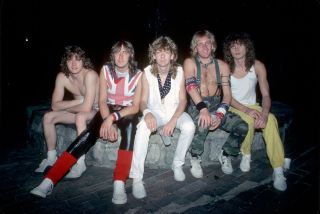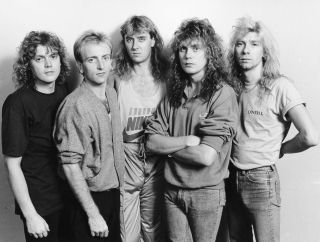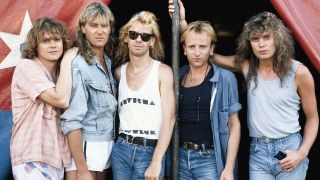In a society increasingly dependent on the dictates of fashion there’s an ever more prevalent, absolute belief that “newer” and “shinier” must equate to better… but is that really the case? Ask the millions of Windows 7 users how they found the upgrade to Windows 8, or the countless thousands who regularly flock to see 70s and 80s ‘Greatest Hits’ tours whilst eschewing new music, and you’ll find the answer is nowhere near as black and white as some would like you to believe.
Most bands get one masterpiece if they’re lucky, but Def Leppard had two… and I’m here to put the case for their first, the mighty Pyromania. After coming to the forefront of the NWOBHM movement in the early 80s, Def Leppard found themselves floundering two albums in when compared to rivals like Iron Maiden and Saxon, particularly in the traditionally strong European market. Mutt Lange had been drafted in to sprinkle some of the same fairly dust he’d used on AC/DC to helm 1981’s High ‘N’ Dry to glory, but the end results simply didn’t deliver. Something had to give, or Def Leppard would surely go under. The masterplan needed a radical revamp!

In January 1982 they entered Park Gate Studios in Battle, East Sussex (once again under the aegis of Lange). Their mission was to emerge with so much more than High ‘N’ Dry Pt. 2. The next eleven (oft frustrating) months were spent piecing together an album the likes of which had never been witnessed before. With tempers frayed to breaking point, former Girl guitarist Phil Collen was drafted in part way through to replace the increasingly out of control Pete Willis, but after an admittedly fractious gestation period the results were nothing short of spectacular: the perfect bridge between the gutsy metal sound of old and the commercial gold dust that was to come.
Having grown up with the familiar chug, chug, chug of On Through The Night and High ‘N’ Dry, opener Rock! Rock! (Til You Drop) was comfortable and familiar, yet at the same tantalisingly different. The sound was enormous, but still firmly grounded in the thumping hard rock of yore, a benchmark trait the often clinical Hysteria lacked. The monumental hooks were something mainstream metal was bereft of, but within four bars you understood that the world as you knew it would never be the same again. And so it continued. Photograph was the perfect single, with its accompanying promo VT that lit up MTV, or the highly contagious riff of Stagefright with its smooth as silk chorus dripping like honey from your speakers.
But Pyromania wasn’t just so much posturing. There was a depth and maturity to songs like Foolin’, Die Hard The Hunter and the moody Billy’s Got A Gun that transcended the normal rules of metal and squared up to pop in a showdown that would produce only one winner. It had taken them a while to get there, but ol’ Midas touch Lange had brought something out of the quintet you would never haven even dreamt existed back in the band’s early days playing shitholes in and around South Yorkshire.
Despite an initially cool reaction from the British press – the same “never let the truth get in the way of a good story!” brigade who’d branded them as sell-outs to America – the sheer quality of Pyromania would ultimately prevail. The US market of course had no such qualms, they lapped it up: sales figures eventually topped the 10 million mark and a raft of hit singles – Photograph, Rock Of Ages and Foolin’ all broke the Billboard Top 30 – kept the band foremost in the minds of the great American public.
It opened the floodgates for a deluge of imitators (few of whom could hold a candle to Leppard), at the same time transforming what was previously the preserve of the feral and disenfranchised into a commodity fit to grace every living room across the land. Ten exquisite tracks with nary a hint of filler in sight (by my reckoning Hysteria is two tracks too long), Pyromania was the blueprint for the generation that followed, and was arguably the greatest album of the early 80s. It may have been more polished and shifted more copies, but without Pyromania blazing a trail, Hysteria would never have been made.
There’s no arguing with that, surely? But wait, here’s Paul Elliott, and he’s not quite so sure…
Pyromania or Hysteria? I’m going with Joe Elliott on this one. “Pyromania was a huge record for us,” the singer said. “But with Hysteria, we took our music to the next level. It’s our best album.”
In most respects there is so little to choose between them. Pyromania and Hysteria are two of the greatest rock albums of all time. Both sold more than ten million copies in the US in the 80s, making Def Leppard one of the biggest bands in the world. And in terms of classic songs, it’s an even match. Pyromania has Photograph, Rock Of Ages, Foolin’, Too Late For Love and Die Hard The Hunter; Hysteria has Animal, Pour Some Sugar On Me, Rocket, Love Bites, Gods Of War, and its title track.

So what makes Hysteria a better record? The answer lies in what Joe Elliott said about taking the music to the next level.
Thinking big was always a feature of this band. As Joe has often stated, the blueprint for Leppard’s music was styled on two of the most successful groups in rock’n’roll history: “AC/DC meets Queen.”
This was not immediately evident on Leppard’s debut album On Through The Night, from 1980, which sounded like so much of the NWOBHM music of the time. But with the follow-up, 1981’s High ‘N’ Dry, they got a little closer to what they were after. Working with Mutt Lange, the producer on AC/DC’s Highway To Hell and Back In Black, Leppard delivered a ballsy hard rock record, heavily influenced by AC/DC, with bigger choruses and slicker vocal harmonies.
Crucially, what the band found in Lange was a guy who was thinking as big as they were. And together they created in Pyromania, an album that set a new standard for hard rock music. As Joe Elliott says in Classic Rock’s new Def Leppard Fanpack, the benchmark for Pyromania was the first Boston album, which had elevated hard rock to a new level of sophistication in 1976, and became the biggest selling debut in American music history until it was eventually overtaken, a decade later, by Guns N’ Roses’ Appetite For Destruction.
On Pyromania, the sound was huge and slick, the band’s classic two-guitar rock power cleverly augmented with synthesisers, drum machines and multi-layered vocals. In 1983, this was the state-of-the-art arena rock record, rivaled only by ZZ Top’s Eliminator.
With Pyromania, Def Leppard became major stars in America, where the album sold six million copies. All that kept it from the number one spot on the US Billboard chart was the album that went on to become the biggest seller in the entire history of popular music – Michael Jackson’s Thriller.
So yes, Pyromania was a great record and a game changer for Def Leppard and for hard rock as a whole. But with Hysteria, they topped it.
With this album, they weren’t trying to outdo Boston. They were aiming much higher – as high as any rock band has ever climbed. They were thinking big on an artistic level. As Joe Elliott said: “We wanted to push the envelope of what rock music was, to make our Sgt. Pepper, a Pet Sounds for the ‘80s generation.” And they were thinking big on a commercial level. Having lost out to Michael Jackson with Pyromania, they conceived Hysteria as, in Joe’s words, “the Thriller of hard rock”.
Thriller was an album packed with hit singles, and that’s what Leppard were going for. In addition, what Jacko had achieved with Thriller was to break down the barriers between black R&B music and rock – most powerfully illustrated by Beat It, the riff-driven hit song featuring a guitar solo by Eddie Van Halen. And that was a strategy employed on Hysteria. “If you want to crossover,” Elliott said, “you have to cross genres and race, like Thriller did.”
Amazingly, they pulled it off. Hysteria yielded seven hit singles: Animal, Women, Pour Some Sugar On Me, Hysteria, Armageddon It, Love Bites and Rocket. It gave Def Leppard the US number one they’d been denied with Pyromania. Moreover, it was the most brilliant and inventive hard rock record of the 80s.
The crossover hits came with Pour Some Sugar On Me, the biggest rap-rock song since the Run DMC and Aerosmith collaboration Walk This Way, and Rocket, a rhythmic tour de force inspired by the 1971 hit Burundi Black. The more orthodox rock hits included Animal and the power ballad Love Bites. There were echoes of Led Zeppelin’s Kashmir in the album’s epic rock song Gods Of War. And throughout it all, Mutt Lange’s production was out of this world. Leppard called him the sixth member of the band, and his genius is at the heart of this album.
Pyromania or Hysteria? It’s a close call. Leppard rocked harder on Pyromania, but with Hysteria they went beyond that, and created a masterpiece.
And most amazing of all? Def Leppard made Hysteria with a drummer who had lost an arm in a car crash. Even now, so many years later, it still seems incredible.

